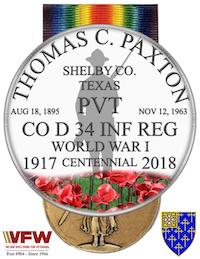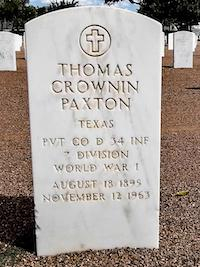 Thomas Crownin Paxton
Thomas Crownin Paxton
World War I Veteran
February 2, 2023 - Born in the dog days of summer, August 18, 1885, Thomas Crowin Paxton entered this world in the county seat of Center, Shelby County, Texas that is located in far East Texas just a few miles from the Louisiana State Line. He was the sixth of seven children to be born to Annie Elizabeth Walding and Sam Paxton, both natives of Alabama. His father died when Thomas was just two years old and the same year his youngest sister May was born. Census records showed that widowed mother Annie never remarried and continued living on the family farm. No doubt the children all had their specific chores to help out.
 With the United States declaring war on Germany on April 6, 1917, nearly three years after the World War began in Europe, a national army was needed, and the Selective Service Act of 1917 provided for this through conscription. The first of three draft registrations was held on June 5, 1917 for men between the ages of 21 and 30. Thomas now 21 complied and registered at Precinct 14 of Shelby County. His registration card showed he was employed by “no one” (although probably working the family farm), single, with no exemption claim to the draft and was of medium height, stout built with blue eyes and dark hair.
With the United States declaring war on Germany on April 6, 1917, nearly three years after the World War began in Europe, a national army was needed, and the Selective Service Act of 1917 provided for this through conscription. The first of three draft registrations was held on June 5, 1917 for men between the ages of 21 and 30. Thomas now 21 complied and registered at Precinct 14 of Shelby County. His registration card showed he was employed by “no one” (although probably working the family farm), single, with no exemption claim to the draft and was of medium height, stout built with blue eyes and dark hair.
Almost a year later Uncle Sam came calling and he was drafted into the US Army in Center on May 22, 1918. Following basic training at the 165 Depot Brigade, Camp Travis, San Antonio, Private Paxton, serial # 3063095 joined Company D, 34 Infantry Regiment, 14 Infantry Brigade, 7 Infantry Division, Camp MacArthur, Texas. The division was in training until the first units that included Thomas’ Company D departed the Port of Hoboken, New Jersey on August 7, 1918 aboard the USS America. He listed his sister Anna as his next of kin. Arriving in France some eleven days later via Liverpool, England they were sent to the Fifteenth Training Area with Headquarters at the Commune of Ancy-le-Franc, Yonne Department.
On September 27 the division departed for the front detraining near the commune of Toul and on October 10 it relieved the 90 Division on the front lines in the Puvenelle Sector. From November 9 to the Armistice, November 11, 1918 the division participated in the general attack made by the Second Army in Meuse-Argonne Offensive. On January 10, 1919 the division moved to the region north of Toul leaving Private Saxton and the 34 Infantry Regiment behind in the devastated area for guard and police duty. During operations the Second Division took 69 prisoners and suffered 1,693 casualties.
On the evening of June 9, 1919, Thomas still assigned to Company D, departed Brest, France aboard the SS Nieuw Amsterdam. The Nieuw Amsterdam with 1,832 soldiers aboard was one of nine transports that left France that night bringing home a total of 30,000 troops from the Sixth and Seventh Divisions. They arrived at the Port of Hoboken, New Jersey ten days later and were transported to Camp Merritt for discharge processing. Honorably discharged on July 2, he was awarded the World War I Victory Medal with clasp that became available the following year.
Thomas returned to the family farm in Shelby County and by the 1920 census his mother now age 59, along with sisters Minnie and May and brother Ray, were living with her in precinct 5 of Shelby County, Texas. By the 1930 census he had moved to El Paso, Texas living with sister May and brother-in-law Paul Atkinson at 3603 Tularosa Street, where he was employed with the civil service at Fort Bliss as a Typewriter Repairman. Having never married he became a lodger at 511 Arizona Street, El Paso while maintaining his government job. The 1940 census showed that he worked 44 hours the last week of March, and in 1939 he earned $1,590 ($30,210 today), and worked all 52 weeks of the year. Mother Annie passed in October 1940 at the age of 79.

With the Japanese attack on Pearl Harbor, Hawaii, December 7, 1941 Thomas would see another World War. On April 27, 1942, he registered for the selective service for the second time in his life at Local Board 3, El Paso at the age of 46. This was sometimes called the “Old Man’s Draft” as those to age 64 were required to register. It was not intended that these men be drafted into military service but to determine if their labor skills could be used in the war effort. He was still employed by the US Government at Fort Bliss and was six foot, one inches tall, 215 pounds, with blue eyes, blond hair and had a ruddy complexion.
Thomas eventually retired from his civil service job and continued to live his life in El Paso at 301 Wenda Way. Having health problems with his heart he entered William Beaumont General Hospital in El Paso where he died on November 12, 1963 at the age of 68. He was a member of El Paso Lodge # 130 AF & AM Scottish Rite Bodies and the El Maida Shrine. Thomas was buried in the Fort Bliss National Cemetery, El Paso, Texas with full military honors. Day is done, God is nigh.









